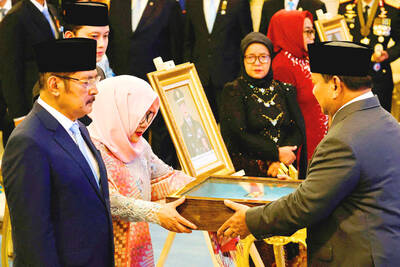Japan yesterday ordered two warships to join an anti-piracy mission off Somalia, one of the most active deployments yet for a military restrained by the country’s post-war pacifist Constitution.
US, European and Chinese naval vessels are already deployed in the Gulf of Aden to fend off pirates behind more than 100 attacks on ships last year.
The two Japanese destroyers with 400 crew were to set sail today for the Gulf to protect cargo ships in one of the world’s busiest shipping lanes near the Suez canal that links Europe with Asia, the Japanese Defense Ministry said.
“Piracy off Somalia is a threat to Japan and the international community,” Japanese Defense Minister Yasukazu Hamada said. “It is an important duty for the Self-Defense Forces to protect Japanese lives and assets.”
The maritime mission has divided public opinion in Japan, which under the post-World War II Constitution permits its soldiers in international disputes to use force only for self-defense and to protect Japanese nationals.
The government planned to submit a bill later yesterday that would widen the scope of force that its military personnel can use against pirates and allow them to protect foreign vessels and nationals as well as Japanese.
The two destroyers — the 4,650-tonne Sazanami and 4,550-tonne Samidare — will each carry two patrol helicopters and two speedboats, to be used by members of the navy’s commando-style Special Boarding Unit.
The ships are expected to arrive in waters near the Suez canal in around three weeks. The period of deployment has not been fixed, Hamada said, but he told reporters that “six months could be an idea.”
Japan’s major overseas missions in the past — including in Iraq, near Afghanistan and as UN peacekeepers — have so far been largely for logistical and rear-area support, such as refueling, transport and reconstruction.
Critics argue this mission could set a new precedent for Japanese military missions overseas and could see the country’s servicemen use lethal force for the first time since WWII.
However, recent newspaper polls have shown growing public support for the anti-piracy mission, with a survey this week by the top-selling Yomiuri Shimbun showing 61 percent of respondents in favor and 27 percent against.
Under the current rules of engagement, the two Maritime Self-Defense Force ships, carrying a combined total of about 400 sailors and coast guard officers, would protect only Japanese ships, nationals and cargo.
Japanese Prime Minister Taro Aso’s Liberal Democratic Party has proposed legislation to allow Japanese troops to fire on the hulls of approaching pirate boats that refuse repeated orders to stop.

James Watson — the Nobel laureate co-credited with the pivotal discovery of DNA’s double-helix structure, but whose career was later tainted by his repeated racist remarks — has died, his former lab said on Friday. He was 97. The eminent biologist died on Thursday in hospice care on Long Island in New York, announced the Cold Spring Harbor Laboratory, where he was based for much of his career. Watson became among the 20th century’s most storied scientists for his 1953 breakthrough discovery of the double helix with researcher partner Francis Crick. Along with Crick and Maurice Wilkins, he shared the

OUTRAGE: The former strongman was accused of corruption and responsibility for the killings of hundreds of thousands of political opponents during his time in office Indonesia yesterday awarded the title of national hero to late president Suharto, provoking outrage from rights groups who said the move was an attempt to whitewash decades of human rights abuses and corruption that took place during his 32 years in power. Suharto was a US ally during the Cold War who presided over decades of authoritarian rule, during which up to 1 million political opponents were killed, until he was toppled by protests in 1998. He was one of 10 people recognized by Indonesian President Prabowo Subianto in a televised ceremony held at the presidential palace in Jakarta to mark National

US President Donald Trump handed Hungarian Prime Minister Viktor Orban a one-year exemption from sanctions for buying Russian oil and gas after the close right-wing allies held a chummy White House meeting on Friday. Trump slapped sanctions on Moscow’s two largest oil companies last month after losing patience with Russian President Vladimir Putin over his refusal to end the nearly four-year-old invasion of Ukraine. However, while Trump has pushed other European countries to stop buying oil that he says funds Moscow’s war machine, Orban used his first trip to the White House since Trump’s return to power to push for

LANDMARK: After first meeting Trump in Riyadh in May, al-Sharaa’s visit to the White House today would be the first by a Syrian leader since the country’s independence Syrian President Ahmed al-Sharaa arrived in the US on Saturday for a landmark official visit, his country’s state news agency SANA reported, a day after Washington removed him from a terrorism blacklist. Sharaa, whose rebel forces ousted long-time former Syrian president Bashar al-Assad late last year, is due to meet US President Donald Trump at the White House today. It is the first such visit by a Syrian president since the country’s independence in 1946, according to analysts. The interim leader met Trump for the first time in Riyadh during the US president’s regional tour in May. US envoy to Syria Tom Barrack earlier